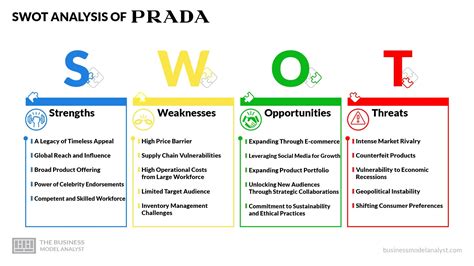prada weaknesses ,Prada pestle analysis,prada weaknesses,Weaknesses of Prada. Some of the main weaknesses in the SWOT analysis of Prada are as follows; Fake Imitation. There are various companies small companies that imitate the design and logo of the luxury brand; manufacture . Furla Bags. Furla has been around since 1927 when it was established in Italy by the Furlanetto family. Since its start, we are focused on creating quality, designer Italian products. Our range of leather bags include bucket bags for women to .

Prada, one of the most renowned luxury fashion brands globally, has long been associated with high-end, innovative designs, sophisticated elegance, and craftsmanship. However, like any major corporation, Prada faces challenges that could undermine its position in the highly competitive fashion industry. This article will explore the various weaknesses of Prada, as part of a comprehensive SWOT analysis, by examining its target audience, target consumers, PESTLE (Political, Economic, Social, Technological, Legal, Environmental) factors, and market positioning. By evaluating these factors, we can gain a clear understanding of the key challenges that Prada faces in maintaining its prestige and profitability.
1. Prada’s Target Audience: Narrow Demographic Focus
One of the primary weaknesses of Prada is its relatively narrow target audience. The brand has traditionally catered to a high-end, niche demographic, focusing on wealthy individuals who can afford premium luxury goods. While this exclusivity contributes to its image as an elite brand, it also limits Prada’s reach. The luxury fashion market is a small, highly competitive segment, and by focusing primarily on a specific group, Prada risks losing opportunities for broader appeal.
The limited demographic scope means that Prada may not be tapping into younger or more diverse consumer groups who are increasingly becoming significant players in the fashion industry. Millennial and Gen Z consumers, for instance, are looking for brands that resonate with their values, such as sustainability, inclusivity, and digital innovation. Prada’s reluctance to move beyond its traditional target audience has prevented the brand from adapting to these emerging trends and demands.
2. Overdependence on High-End Fashion and Accessories
Prada is primarily known for its high-end clothing, bags, shoes, and accessories. While these products are highly desirable, the company’s heavy reliance on luxury fashion items exposes it to the risks of market saturation, economic downturns, and shifts in consumer preferences. As the global economy fluctuates, discretionary spending on luxury goods tends to decrease, which can result in a drop in sales for brands like Prada.
Additionally, fashion trends change quickly, and what is considered desirable today might be out of style tomorrow. This constant need to innovate and stay ahead of trends places enormous pressure on Prada to continually release new collections. If the brand fails to meet evolving consumer tastes or if a collection flops, it could significantly hurt its brand image and revenue.
3. Challenges with Brand Perception and Image
Prada, while highly respected in the fashion industry, faces some challenges in maintaining its brand perception. Over the years, the brand has been accused of being too focused on elitism and exclusivity, which can alienate a broader audience. While exclusivity is a key trait of many luxury brands, Prada’s image is often seen as distant or even inaccessible to average consumers.
Moreover, Prada has faced criticisms regarding its marketing strategies. The brand has been slow to embrace more inclusive and diverse marketing campaigns, which has led to concerns about its relevance in a rapidly changing cultural landscape. Young consumers today are more likely to gravitate toward brands that showcase diversity, sustainability, and social responsibility. Prada’s lagging efforts in this regard could hurt its image, particularly among younger, socially conscious shoppers.
4. PRADA PESTLE Analysis: External Challenges
To fully understand Prada’s weaknesses, it is essential to analyze the external factors affecting its operations using the PESTLE framework (Political, Economic, Social, Technological, Legal, Environmental).
- Political: Prada, like many global luxury brands, is subject to international political tensions and regulations. Trade policies, tariffs, and import-export restrictions in different countries can impact its supply chain and pricing strategy. For instance, in recent years, the trade war between the US and China has raised concerns for many global brands that rely on international trade. Prada, which has a significant presence in China, is vulnerable to changes in international political dynamics.

prada weaknesses A prized possession in its truest sense, Gucci bags are not priced ordinarily. And if you are not ready to break the bank to buy one, there are some designer alternatives to check .
prada weaknesses - Prada pestle analysis